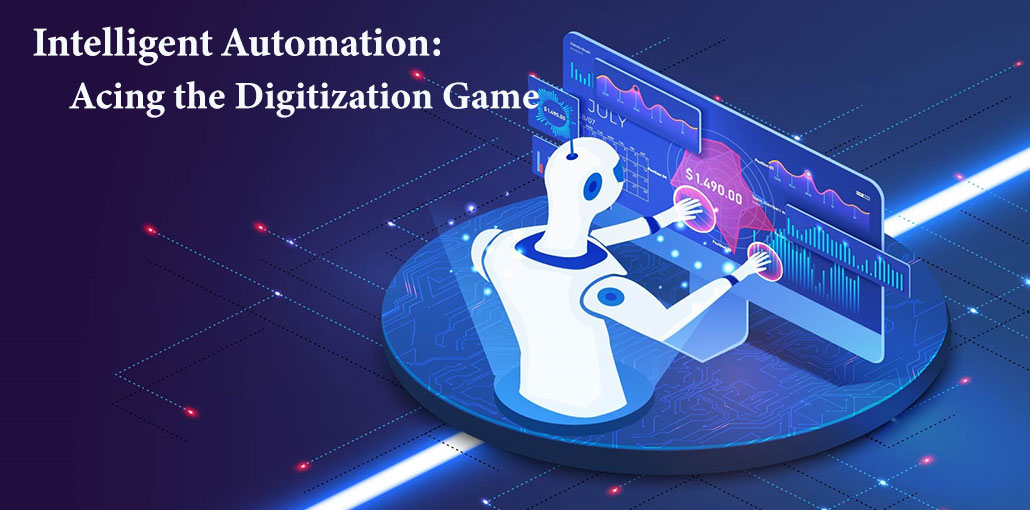Intelligent Automation is a collection of solutions that includes Intelligent Document Processing (IDP), Robotic Process Automation (RPA), AI/ML, and sophisticated analytics. To solve the issue statement or business requirement at hand, these products can be utilized alone or in combination.
It boosts the processes’ efficiency to new heights. Because of its process-intensive nature, the banking, financial services, and insurance (BFSI) industry are naturally the first to implement the technology. Businesses in other industries, such as manufacturing and logistics, retail, and others, are now moving to Intelligent Automation adoption for renewed inspiration to automate repetitive operations, thanks to its rapid adoption across the US, Europe, APAC, and EMEA.
Businesses can seamlessly improve revenue and savings year over year by utilizing Intelligent Automation.
Highly competent professionals typically undertake swivel chair operations, data input, validations, formatting, and other tasks on a daily basis as part of their work profiles, leaving them less time to focus on their core competency. Intelligent Automation automates the tedious, repetitive operations in this scenario, allowing leaders to focus on boosting business prospects. We now have a set of critical Intelligent Automation and RPA use cases to help medium and small businesses get started with Automation (MSMEs).
Intelligent Automation usage is expected to increase and grow at a CAGR of 40% as a result of this, sources suggest.
Also read: What Is Workflow Automation And Why Do You Need?
Strategies for Intelligent Automation Adoption
The best approach to establishing Intelligent Automation projects is to start with a problem statement and then deploy Lego-like automation components –
IDP allows you to extract unstructured data from paper documents and transform it into a structured representation, which is considerably more effective than OCR. It is capable of continual learning and works without a template. IDP provides more than 99 percent accuracy thanks to its picture pre-processing and data post-processing functionalities.
RPA’s universal recorder can automate medium to complicated processes and perform multi-way data transfers of the resulting structured data between legacy systems and ERP, cloud, Citrix, and other systems.
Through continual machine learning, AI / ML allows us to extend the same use cases further and go where no man has gone before, automating human decision-making and exception management.
The analytics module performs sophisticated analysis of various data points and delivers breakthrough analytics to help you make the most use of your resources.
Let’s now go through some of the major functionalities:
Various modeling is done in order to intelligently generate first-time-right (FTR) output with a high level of certainty. It checks each node’s data generation and transfers against pre-defined rules and master tables. It mostly focuses on exceptions that can’t be handled.
KYC, accounts payable processing, health claim document processing, and banking & treasury operations are some of the most common use cases for end-to-end automation.
Areas that demand a high level of compliance and strict adherence to deadlines are also great candidates.
Another extremely significant use case is trade finance document processing or end-to-end EXIM automation across geographically dispersed players. It takes advantage of the previously mentioned stack of reusable RPA use cases and serves as a springboard for holistically embarking on and thriving on the automation journey.
When compared to point solution automation, Intelligent Automation executed through a Centre of Excellence (CoE) provides the maximum benefit and year-over-year savings. It guarantees that the bots get the most traction and are used to their full potential. It enables maximum throughput through constant bot and system health checks, as well as the deployment and redeployment of bot resources across various departments and segments, assuring maximum ROI and productivity.
The best aspect is that the Intelligent Automation modules are compatible with all current products and popular technologies, allowing for end-to-end and adaptable automation solutions. A vendor with in-house domain knowledge and extensive solutions and services experience may fill in the gaps left by existing automation and give a bespoke solution to comprehensive installations with the least amount of bot resources. The vendor can drive automation towards DIY self-sufficiency via a Build-Operate-Transfer method.
Also read: 12 Recruiting KPIs to Measure Your Organization Success
Intelligent Automation’s Advantages
- Consistent performance in a time crunch: Provides a tried-and-true solution in deadline-driven environments with first-time-right output.
- Modular approach: Allows users to pick and select productivity automation modules to solve a specific problem or meet a specific business need.
- Auto-learning: Constantly learns by managing exceptions and using machine learning.
- Unstructured data: This type of data is used to create a structured output that can be used to create end-to-end solutions rather than just point solutions.
- Diversity: At one end, it automates mainframes and legacy systems, while at the other end, it automates modern ERPs, Cloud systems, and Citrix environments.
- Use cases and components that can be reused: Creates a library of use cases and components that can be reused across the enterprise and its ecosystem.
- Fraud detection: Increases transparency and visibility at each node, highlighting outliers or fraud.
- Increase revenue: Maximize ROI and save money by utilizing Intelligent Automation.
Intelligent Automation’s Future Prospects
New innovations and automation use cases emerge as Intelligent Automation adoption rises. Every day, new proofs of ideas, or PoCs, are being developed that were never dreamt of before. AI-enabled RPA use cases based on real-world scenarios are giving an edge and opening up new research possibilities for improving productivity, profitability, and targeted growth.
In this place, handwritten text is becoming a behemoth. The computational models are now being trained, and the accuracy of the collected handwritten text is being improved. The scope of Intelligent Automation is anticipated to expand dramatically as a result of this advancement. The demand for consulting and proof-of-concept development is expected to peak in the near future.
Conclusion
The Intelligent Automation suite’s modular design allows businesses to not only kickstart operations but also to fill in gaps in existing automation investments to give competent, worldwide solutions. The various models employing IDP, RPA, AI/ML, and Analytics are deployed through a CoE to resolve problem statements and provide FTR output time and boost productivity and efficiency, allowing organizations to grow YOY revenue and savings.
In parallel, Intelligent Automation creates reusable use cases and automation components that can be duplicated across the organization and its ecosystem. The modules are compatible and interoperable with leading products and technologies, allowing a vendor with experience delivering solutions and services to bridge the gap between existing automation installations and end-to-end Intelligent Automation solutions.










Leave a comment